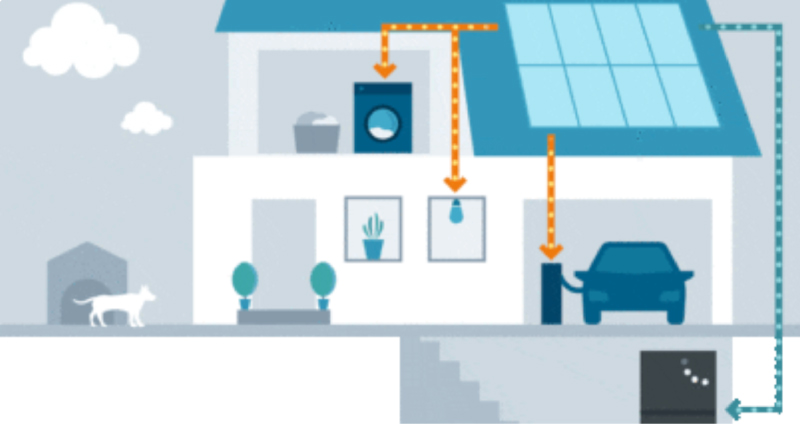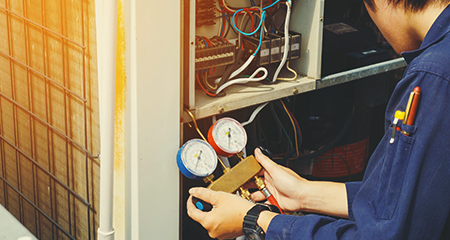1. Switch to LEDs.
This spring, make the switch to energy-efficient lighting in your home. Incandescent light bulbs produce a lot of heat and use more energy than LEDs. Swapping those out for the greener option will save energy and produce less heat. Keeping the room temperature low is essential during the hot summer months!
LED light bulbs can use up to 90% less energy and last 15 times longer than incandescent bulbs. It is worth making the switch.
2. Program the thermostat.
If you have an air conditioner, programming your thermostat can help you save energy this cooling season. For example, you can set the temperature a few degrees warmer when you’re away from the house during the day. Even raising the thermostat by just 1°C over eight hours can show noticeable savings on your electricity bill.
3. Get an AC tune-up.
An annual air conditioner service can ensure it’s running safely and efficiently and prevent breakdowns. Contact a reputable HVAC company for an air conditioning inspection and tune-up.
You should also replace your air filter. You can check the manufacturer’s instructions for how often you should change it, but starting the season with a fresh filter is a good idea. Clogged air filters can strain your system and reduce efficiency and indoor air quality. Read more about air conditioner maintenance.
4. Check the ceiling fans.
If you have cool air in your home, from open windows in the evening or your AC, use your ceiling fans to circulate that air! A fan won’t cool the air, but it can help lower your energy bill by moving cool air around and making things feel more comfortable. Make sure your fans rotate counterclockwise in the summer. This will produce a downdraft that pushes cool air into the space below. Using fans can make things feel cooler without adjusting the thermostat.
5. Inspect your windows and doors.
If cleaning your windows is on your spring cleaning checklist, check the tracks and seals while you’re at it. If dirt has collected in your window and door tracks, they won't seal properly. Your nice, cool air will leak out of those tiny gaps! If cleaning doesn’t do the trick, head to the hardware store and pick up some weatherstripping. You pay for that cool air, so let’s keep it inside!
6. Use window shades.
If you have windows that don’t have window coverings, install them this spring. Window coverings, like blinds, shades and drapes, will block light and heat from the sun. They act as an extra layer of insulation and help keep your home cooler. That means your AC doesn’t have to run as often, and you can save on energy bills.
7. Check your fridge.
Your fridge is a significant energy consumer. After your heating and cooling systems, the running refrigerator is the biggest energy sap in the house. Ensure your fridge door is sealing properly to prevent cool air from escaping (and keep your food fresh)!
Also, remove the little grate at the bottom of your fridge and check the coils. They’re likely covered in dust, making the fridge work harder to keep your food cold. Clean them off with a vacuum cleaner.
8. Don’t run the dishwasher in peak heat.
Your dishwasher is also a major energy consumer. While it’s running, it heats up and that will warm your home. Avoid running the dishwasher during the hottest hours and save it for the cool evening.
The average dishwasher uses about 6 gallons of water per cycle! To conserve water and energy, consider washing your dishes by hand on those scorching days.
9. Clean your washing machine.
Your washing machine helps to clean your clothes. Why not return the favour? A dirty washing machine doesn’t clean your clothes as well. Dirt and lint collect in plumbing traps, while soap can build up on the sides and edges of your wash tub. This buildup can even lead to mould and mildew growth.
To prevent this, give your washer a cleaning this spring! You can purchase a washing machine cleaner that runs on an empty cycle and keeps the machine fresh. You can also learn how to clean a washing machine thoroughly.
10. Replace old appliances.
According to Natural Resources Canada, appliances can account for over 14% of the total energy used in your home. If your appliances are old, consider upgrading to energy-efficient models. This upgrade can help you save on your bills and reduce your environmental impact. While researching your options, look for ENERGY STAR certification.
Start saving energy today!
Energy-saving tips can help you adopt simple habits that reduce your carbon footprint and lower energy bills. These changes can help you maintain your home and make it a more comfortable place for you and your family.

























